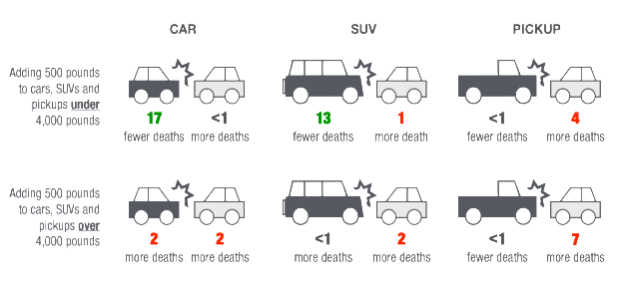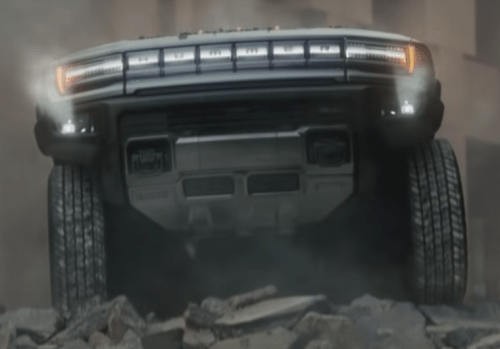The “SUV arms race” is over — if you want it. But automakers and policymakers seem intent on continuing to make America's super-sized vehicles even bigger anyway.
According to an updated analysis of recent crash data by the Insurance Institute for Highway Safety, heavier cars and trucks actually don't make their occupants significantly safer, at least when vehicles exceed a threshold of about 4,000 pounds — and the average American car is already weighing in at a whopping 4,100.
Put another way: there's no real safety justification for making America's famously bloated fleet any heavier than it already is.
That finding might come as surprise to U.S. car buyers, who have long been locked into what economics professor Michelle J. White once memorably called an "SUV arms race" to buy the biggest cars they could afford, in hopes of increasing their own chances of survival in a potential crash by simply being in the larger vehicle. And for many years, analysts found that hope was justified, because the occupants of bigger cars did fare better on impact.
In recent years, though, advances in other vehicle safety strategies like better front-end design and automatic emergency braking have increased the "crash compatibility" of average-sized vehicles, making the occupants of those cars more likely to survive being hit by the driver of a monster truck — though not necessarily sparing the lives of people outside cars when those drivers strike them.
"When [a car] gets above that average weight of the overall fleet, you're basically already as safe as you're going to be from raw weight alone," said Sam Monfort, senior statistician at the Institute and the author of the report. "But you can keep increasing risk to other people as you add more weight onto your vehicle."

For people outside cars, of course, increasingly vehicle weights do have an impact, though counterintuitively, that's mostly because high curb weights are heavily correlated with increases in height, aggressive front-end design, and other design features that bring the hood of a vehicle directly in line with a pedestrian's head or a cyclist's vital organs. When cars are designed with less-blunt front ends on a chassis positioned lower to the ground — two design features that are often associated with lighter vehicles – they direct the force of an impact to legs, where a road user's injuries are more likely to be survivable.
Placing drivers higher off the ground also affects their perception of their own speed, making them more likely to hit fatal velocities when they strike walkers; heavier cars, meanwhile, also need thicker "A pillars," which increases the size of blind spots, particularly when drivers turn.
“It’s kind of an unexpected finding, but what we consistently find is that vehicle weight doesn't predict poor crash outcomes for pedestrians and bicyclists, largely because the weight discrepancy is so large already," added Monfort. "Whether you're struck by a 3,000-pound vehicle or a 5,000-pound vehicle, you're still so outweighed. ... So vehicle weight is not really what matters. What does matter are [factors like] the front end shape of the vehicles and size."
Monfort stressed that virtually all automakers are already making safety upgrades voluntarily – even if the ones that would specifically benefit vulnerable road users aren't always on the list.
Back in 2009, for instance, the Alliance of Automobile Manufacturers and the Association of International Automobile Manufacturers entered into a voluntary commitment to improve vehicle-to-vehicle crash compatibility by better aligning the energy-absorbing structures between their respective vehicle models, a move which he suspects shaped the improved safety stats he found in his recent analysis.
And while regulators under President Trump are unlikely to mandate new safety updates to protect vulnerable road users — especially since they've already frozen several Biden-era proposals that would have required things like pedestrian automatic emergency braking — it's not impossible that automakers will fill the void and commit to installing that tech on their own.
Even if they don't, Monfort hopes consumers will get the message that bigger doesn't always mean safer – and stop the SUV arms race before it gets any worse for people who don't drive.
"When people are searching for a vehicle to buy, [often] their chief concern is safety," he adds. "I hope they understand that with modern vehicles, you don't need to rely on raw weight alone to protect you."






